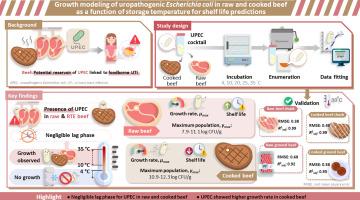生牛肉和熟牛肉中尿路致病性大肠杆菌的生长模型作为储存温度的函数,用于保质期预测
IF 5.2
1区 农林科学
Q1 FOOD SCIENCE & TECHNOLOGY
International journal of food microbiology
Pub Date : 2025-07-22
DOI:10.1016/j.ijfoodmicro.2025.111359
引用次数: 0
摘要
在这项研究中,我们调查了台湾零售牛肉中尿路致病性大肠杆菌(UPEC)的存在,并评估了储存温度对生牛肉和熟牛肉中UPEC生长的影响。总共使用平板计数法分析了50份牛肉样品中的大肠杆菌,并通过聚合酶链反应鉴定了UPEC。此外,将包括两株本地分离菌株在内的四株UPEC鸡尾酒接种于生牛肉和熟牛肉上,并在4、10、20、25和35°C下孵育。生长数据采用四个主要模型(Huang, Baranyi,重新参数化的Gompertz和无滞后期)进行拟合,而次要模型(Ratkowsky和Huang平方根)用于评估温度对生长速率的影响。从抽样活动中,在5/30(16.7%)生牛肉和2/20(10.0%)即食牛肉样本中检测到UPEC。在挑战试验研究中,两种牛肉的生长都发生在10至35°C之间,滞后期可以忽略不计。无滞后期模型对生牛肉采用Ratkowsky平方根,对熟牛肉采用Huang平方根,拟合效果最佳(均方根误差(RMSE)为0.036 ~ 0.095)。生牛肉和熟牛肉的最低生长温度分别为5.8±2.1°C和6.4±0.7°C。在30°C下进行验证,证明了原料的可靠预测(RMSE, 0.38 log CFU/g;R2adj, 0.99)和煮熟(RMSE, 0.49 log CFU/g;牛肉夹头。对碎牛肉的预测仍然可以接受(RMSE,生牛肉0.68,熟牛肉0.58)。并根据所建立的模型绘制了货架寿命图。这些发现强调了零售牛肉中UPEC的存在,并为UPEC的生长提供了一个有效的预测模型,该模型可以应用于微生物风险评估。整合预测建模和保质期估计为食品零售商和肉类行业提供了一个有价值的工具,使更准确的UPEC增长预测和加强微生物安全策略。本文章由计算机程序翻译,如有差异,请以英文原文为准。

Growth modeling of uropathogenic Escherichia coli in raw and cooked beef as a function of storage temperature for shelf life predictions
In this study, we investigated the presence of uropathogenic Escherichia coli (UPEC) in retail beef in Taiwan and evaluated the effects of storage temperatures on UPEC growth in raw and cooked beef. In total, 50 beef samples were analyzed for E. coli using plate count methods, with UPEC identified via a polymerase chain reaction. In addition, a four-strain UPEC cocktail, including two locally isolated strains, was inoculated onto raw and cooked beef and incubated at 4, 10, 20, 25, and 35 °C. Growth data were fitted using four primary models (Huang, Baranyi, reparameterized Gompertz, and no-lag phase), while secondary models (Ratkowsky and Huang square-root) were used to assess temperature effects on growth rates. From the sampling campaign, UPEC was detected in 5/30 (16.7%) raw and 2/20 (10.0%) ready-to-eat beef samples. In challenge-test studies, growth occurred in both beef types between 10 and 35 °C, with negligible lag phases. The no-lag phase model, combined with Ratkowsky square-root for raw beef and Huang square-root for cooked beef, provided the best fit (low root mean squared error (RMSE), 0.036–0.095). The estimated minimum growth temperatures for raw and cooked beef were 5.8 ± 2.1 and 6.4 ± 0.7 °C, respectively. Validation at 30 °C demonstrated reliable predictions for raw (RMSE, 0.38 log CFU/g; R2adj, 0.99) and cooked (RMSE, 0.49 log CFU/g; R2adj, 0.99) beef chuck. Predictions for ground beef remained acceptable (RMSE, 0.68 for raw, 0.58 for cooked). Moreover, shelf life charts were developed based on models established in this study. These findings underscore the presence of UPEC in retail beef and provide a validated predictive model for UPEC growth which can be applied to microbial risk assessments. Integrating predictive modeling and shelf life estimation offers a valuable tool for food retailers and the meat industry, enabling more-accurate UPEC growth predictions and enhancing microbial safety strategies.
求助全文
通过发布文献求助,成功后即可免费获取论文全文。
去求助
来源期刊
CiteScore
10.40
自引率
5.60%
发文量
322
审稿时长
65 days
期刊介绍:
The International Journal of Food Microbiology publishes papers dealing with all aspects of food microbiology. Articles must present information that is novel, has high impact and interest, and is of high scientific quality. They should provide scientific or technological advancement in the specific field of interest of the journal and enhance its strong international reputation. Preliminary or confirmatory results as well as contributions not strictly related to food microbiology will not be considered for publication.

 求助内容:
求助内容: 应助结果提醒方式:
应助结果提醒方式:


